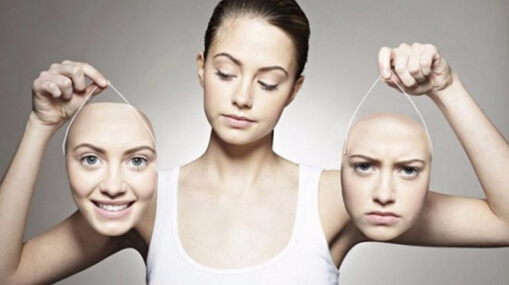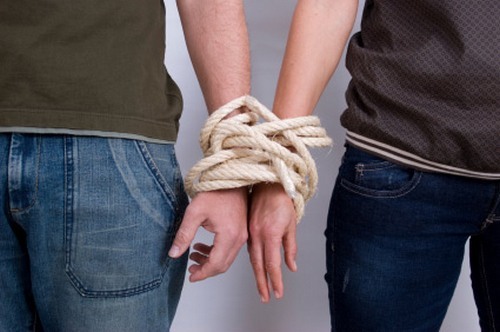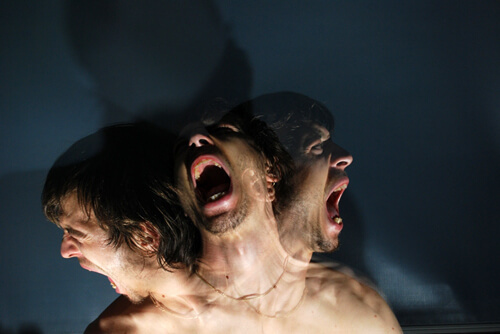Bipolar disorder
 Bipolar disorder is a mental illness caused by endogenous factors. It greatly complicates all manifestations of the existence of personality. For the first time, bipolar personality disorder has been described in France, but it was not immediately accepted by the scientific community, because during the intermission the patient is fully preserved and not defective, intellectual development remains the same. Only Kraepelin describes and introduces this nosology in detail.
Bipolar disorder is a mental illness caused by endogenous factors. It greatly complicates all manifestations of the existence of personality. For the first time, bipolar personality disorder has been described in France, but it was not immediately accepted by the scientific community, because during the intermission the patient is fully preserved and not defective, intellectual development remains the same. Only Kraepelin describes and introduces this nosology in detail.
Symptoms of bipolar disorder is a transition from mania, with a healthy window after it, to a depressive phase. Often for a few consecutive depressions there is a mania. Mania is inexpressive and carries the term hypomania, it is easier to stop. Depression in the subform is more easily tolerated by patients, hence the term - subdepression.
Bipolar disorder: causes of
There was no direct correlation between the formation of bipolar disorder and age of the scientists. But it is known that it often occurs in young people. The exposure of women to this disease is much higher than that of men, some studies link it to the complex cyclic change of hormones in the menstrual cycle in women. After all, it is not new that the female sex and in normality there are sharp jumps of mood.
Scientists of different countries have repeatedly investigated the causes of bipolar disorder by all known methods, but they have not reached a unanimous conclusion. It is necessary to understand the fact that it is impossible to single out one reason, this disease is multifactorial.
Not the last reason is the genetic inclination. It is known that offspring whose parents had bipolar disorder, the chances of having this disease are higher than in the general population. It is proved that there is a group of genes in the human genome that are responsible for this disease, therefore DNA carries these pathological structures, but the percentage of their manifestation in the phenotype is not so high. Therefore, it is important to know whether the blood relatives were ill, but this does not confirm and does not refute the disease by 100%.This is confirmed by the study of the disease on mono-egg twins.
Not the last role is assigned and psychosocial reasons. Many psychoanalysts give considerable importance to the upbringing of the child and the parental attitude toward it. If the child was given little attention, demanded too much or unfairly from him, then in the future he is more prone to any mental pathologies, and bipolar disorder is no exception.
External factors, such as severe psychotraumatic stress, a great grief or a serious physical illness, can also cause bipolar disorder. For a person, mentally - this is a way to forget, throw an unpleasant episode from life, how to abstract from it. At first, such mood swings develop as a defense mechanism against stress, but if stress is long, the adaptive capabilities of the psyche run dry and they become pathological. At the same time, stress is only a provocateur of the disease, further exacerbations arise regardless of stress. Depression reflects a sense of inferiority, and mania is the way the body protects it.
Not the last reason found after the emergence of objective methods of living brain research is a biological cause. It is based on the pathology of synthesis, exchange and capture of important neurotransmitters of the central nervous system. The neurotransmitters responsible for the person's mood include: norepinephrine, serotonin, dopamine. It is with a violation of their balance and the formation of bipolar disorder is associated. Depending on the stimulation of the cerebral cortex and the phases of the disease will be formed, so in the mania the amount of dopamine and norepinephrine increases in significant proportions and leads to hyperstimulation of some parts of the brain, and when depression the amount of serotonin is significantly reduced and leads to a lack of stimuli in certain parts of the cortex of the brainBrain.
An important moment directly affecting the development of the disease is the neurohumoral work of the body. In fact, the pathology of the hypothalamus, which is the highest organ of regulation of the human hormonal system, directly leads to disruption of the pituitary gland, and it is subsequently responsible for the regulation of all other endocrine systems. Thus, defects in the adrenal, thyroid, and human biorhythms are formed, which in the future will lead to bipolar disorder.
Bipolar disorder: symptoms of
Symptoms of bipolar disorder are characterized by primary mood changes that change with remissions. It is most convenient to consider it in the context of violation of emotions.
Each patient is individual in the number of phases, the speed of their rotation, and the presence of intermissions. The duration of a certain period is different, sometimes a week, or maybe a couple of years. But depressive always exceed in duration manic.
Bright periods, when signs of bipolar disorder is not observed, can last eight years, and in severe forms, they are not expressed.
Manic episode is characterized by excessively inadequately good mood. A man does not make any complaints, he is very self-satisfied. He perceives the environment very bright, considers himself beautiful, ingenious and completely self-sufficient. Patients are nervous, can not sit, chaotically move. Their activities are often unproductive, but they do it without the slightest fatigue. There is an acceleration of thinking and acceleration of speech. Increased feelings of energy, patients often talk about inexhaustible energy, their own capabilities are overestimated. Develop new ideas, start a new entrepreneurial or scientific activity, seek to write books, compose songs. Cases do not end because of pronounced distractions and a decrease in the ability to concentrate attention. They have many plans and do not see any obstacles. There is a jump in ideas, when ideas change so quickly that the patient does not have the opportunity to grab them.
All the instincts of personalities with mania are greatly amplified, the person is voracious, intimately disinhibited and indiscriminate in the choice of partners. If they contradict or argue with them, they cease to control themselves and can become aggressive. Their actions are not always adequate, they are tactless.
There are many kinds of mania. Cheerful, or solar mania is characterized by a good mood. They are prone to posing, joking. The feeling of the disease is absent. Hypersexuality is observed. Expansive mania is also characterized by an elevated mood, but it is combined with self-exaltation, the ideas of omnipotence. Although they are not crazy, they can be persuaded. Mania with a jump of ideas - the acceleration of associative thinking, is clinically similar to the torn thinking. Gnevlivaya mania has symptoms of irritability, with displays of anger and aggression, these individuals are unhappy and conflict. Confused mania - a good mood is combined with elements of impaired consciousness. Mania is a manifestation of many diseases of the psyche, including acute intoxication.
Mania with a light current is called hypomania. It includes all the previous symptoms, but in mild form. Patients feel a spiritual uplift, very well remembered, always cheerful.
The depressive episode is characterized by the opposite symptomatology. The person is depressed, the mood is pathologically bad, regardless of surrounding factors. To such people it is very bad, especially in the mornings. They think and talk very slowly, their thoughts flow like a thick kissel and it is difficult for them to turn their tongues, as if it is very heavy. Their thoughts are unhappy, down to the ideas of self-blame, self-abasement and their own sinfulness. These thoughts are very unpleasant to the patient. Patients are not energetic, initiativeless and very pessimistic. Sometimes they do not find the opportunity to get up and cook their own meals, even do not leave the room. All instincts are very weakened, there is no appetite. They suffer from insomnia and impotence, suicidal thoughts appear. All events are very gloomy.
Some patients develop somatic complaints, such as increased heart rate, constipation, dryness of mucous membranes. Very often they sharply reduce weight.
There are several types of depression. Anxious depression is an aggravating, painful expectation of imminent misfortune. Apathetic depression is characterized by the weakening of all stimuli, the patients are indifferent to everything around and to their own person and ask only to leave them. Anesthetic depression is characterized by pain for the patient's mental insensitivity. With masked depression, various disorders predominate behind the type of depressive equivalents, for example, they have a heart and stomach. In such a course, the patient unsuccessfully appeals to all doctors until he gets to a psychiatrist.
Melancholic raptus is a condition where the motor inhibition of a depressed patient suddenly changes to an attack of excitation, an explosion of anguish. The patient is undermined, can inflict self-harm or even kill himself. If it is contained, it weakens and again becomes inhibited.
Bipolar personality disorder occurs in complex forms of bipolar disorder, when a mania without a light window is transformed into depression. And this state is often repeated. In such patients heredity is usually burdened.
Bipolar disorder of the psyche is a psychosomatic symptom manifested in a long-term illness. It can be all sorts of hallucinatory experiences, ideas of greatness in mania. With depression, the world for man is absolutely gloomy. Personality perceives itself as pitiful and destitute.
Types of bipolar disorder
The term bipolar disorder may not be correct, because monopolar disorders are also part of their structure.
Isolate bipolar disorder of several types. This classification is mainly used in American medicine, but a very simple division and correct description makes it relevant in our model of psychiatry.
Bipolar disorder of the first type is a typical course that manifests itself in an episode of the classical manic phase with hypertension, acceleration of thoughts and motor disinhibition. Also for this type is characterized by the presence of a mixed phase, when they change rapidly. Mixed affective phase is a state of triad disturbance, when a part of the triad, for example from mania, is opposite to another part, which is a symptom of depression. These conditions are very common and hard to stop.
These can include agitated depression, when a person instead of inhibition experiences agitation - unintentional motor excitement, it can be considered an extreme degree of anxious depression. This can include depressed, in the structure of which a jump in ideas.
Some types of mania also belong to mixed forms. The inhibited mania arises when the patient is in a mood, but he has no increase in the motor sphere. Dysphoric mania, on the contrary, is manifested by increased craving for movement, but instead of a good mood, patients are angry. With an unproductive mania there is no intellectual upsurge. And in the structure of this type is possible and the presence of depression.
Bipolar disorder of the second type has absolutely different characteristics from the previous one. In this type of person will never experience an episode of full-fledged mania. But hypomania and severe significant depression episodically enter into this disease. At the same time, hypomania is short and does not cause significant discomfort to the patient, but depression has a pronounced course. This can occur with severe psychosomatic symptoms. It is manifested by a typical triad: hypothyroidism, motor inhibition and a decrease in the speed of thinking.
Bipolar disorder of the third type is different from the previous ones. Another term for this type is cyclothymia. With it there are cyclically oscillating hypomanias and sub-depressions. To expose this form it is important to have full-fledged characteristics of depression, namely hypotension, motor braking and intellectual inhibition. Cyclotemia is a relaxed bipolar disorder, in which the symptoms are much paler.
There is another very difficult to define option under the term fast cycling. And they are significantly different from the mixed phase. At the same time there are at least four episodes of any signs of bipolar disorder. Between them there can be a period of a healthy "window", not infrequently there is such a complication as the inversion of affect. Then a certain phase abruptly passes into the opposite phase. An important criterion is the length of the episode, the depressive should last a fortnight or more. Well, hypomania - 4 days or more. This type of flow is prognostically negative.
Bipolar personality disorders include the above-mentioned types and are seasonal. After all, changing the time of the year often gives rise to a change in mood and leads to one of the phases. Bipolar disorder of the psyche includes psychotic symptoms, it helps to distinguish these species. The course of both species can be combined. It is very important to carefully determine the type of bipolar disorder because this can greatly affect the course of the disease and treatment.
Bipolar Disorder: Diagnosis
Like most diagnoses in psychiatry, bipolar disorder can not be diagnosed by objective methods. The best method for this is psychiatric conversation. It is better to interview the patient according to the approved scheme.
First, complaints, they are explained in detail in the symptoms section. Next, describe the personality psychosis. The patient is conscious, except for confused mania, in which a person may have elements of a disturbed consciousness. Mood: with depression, pathologically bad, and with mania pathologically good. Emotions: with depression, hypotension is a pathological weakening of emotions, and with mania, hypertension. Thinking depends on the phase: accelerated with mania and slowed down with depression. But it is consistent, the patient is adequate. Also, if a person is in a mania, then he talks with pleasure, he is verbose, but the speech may not be in fact, there are ideas of one's own greatness. In case of depression, the patient reluctantly contacts, questions are answered unilaterally, after a long pause, ideas of self-blame, sinfulness, inferiority are possible. In the manic state, aggression is possible, does not recognize itself as a patient, that is, there is no criticism. They are talkative, bothersome, constantly trying to intercept the initiative in their own hands. With depression, criticism is also reduced. With depression, even if it is with a slight current, a person always carries suicidal thoughts, but in most they hide it, do not share their experiences. Such patients are anxious, ask about all aspects of their treatment, are very worried. It is very important to understand this and to monitor these patients. At mania, hypermemia is observed in patients, they perceive the world as bright, colorful and remember the smallest details. With depression, patients often have memory loss, mainly for current events, but after treatment, memory comes back to normal.
Intelligence in bipolar disorder: intellectual abilities do not change. Also you need to ask whether there is a link with the time of year and the period of the day. In addition, exacerbation is more often in autumn or spring. And depressive patients will clearly say that by the evening they are getting better, and in the morning their condition is the worst.
It is also important to ask relatives who will tell that the manic patient is hypersexual, gluttonous, sleeps little and constantly gets involved in "profitable" projects. And about the patient in depression they will say that he is apathetic, practically does not eat, sleeps a little and does not help at all in the house. It is important to ask whether this situation first arose about the prescription of the beginning.
You can not miss the collection of a life history, it is important to know if the relatives were sick of such diseases.
Bipolar disorder can be set if episodes of a pathological mood change have been recorded two or more times. Significance has a previously revealed episode of mania or hypomania, this positively affects the selection of treatment and improves prognosis for the patient.
Of the tests that psychologists have, you need to apply the questionnaire PHQ9, which is recommended by the Ministry of Health. And also the Spielberger scale, which allows to reveal the personal and situational level of anxiety, psychological questionnaires of the presence of depression and suicidal activity of Beck( BHS).But first, ask the patient two questions from PHQ2, whether you often have a low mood or longing for the past four weeks, whether your interests and attitudes to life have changed, especially the interest. If a person responds positively to something, then give him all the psychological tests. The questionnaire for identifying mania is MDQ, which includes 15 questions.
Bipolar disorder: treatment of
In the presence of psychomotor agitation, depressive stupor or suicidal tendencies, the patient must be kept in a strictly supervised regime. When the status is improved, the mode can be changed to diff. Supervision.
Manipulation of an episode of mania
Initial therapy of such patients is antipsychotics - sedatives and timostabilizers, for example, lithium salts, in complex with them act anticonvulsants, for example valproate. The second line agent is Carbamazepine 200-400 mg / day.
The advantage should be given to second-generation antipsychotics, especially when it is necessary to stop manic agitation: Clopixol-Acupase 50-100 mg, 1-3 ml IM, Azapine 100-200 mg / day orally, Quetiapine 300 to 600 mg / day. You can also use Rispolept 2-4 mg / day, Serdalekt 4 mg once a day, add four mg can be taken every week, Aminazine 0.025-0.075 g 2-3 times a day, Propazin 2 g / day, Tizercin 25 to 50 mg /A day in several receptions. Well manifested themselves in the action on the mania phase and such drugs: Olanzapine 5-20 mg / day, Risperidone 1 mg 2p / day, maximum increase in daily dose of 10 mg / day, Aripiprazole 20-30 mg / day, Ziprasidone 40 mg in 2 divided doses/ Day orally during meals, the dose can be increased to 160 mg.
If signs of resistance to drugs last more than four weeks, you need to apply biological therapy - electroconvulsive therapy.
To restore the patient's ability to cooperate within the therapeutic process, it is important to use rehabilitation and psycho-educational programs as early as possible with patients and their loved ones.
Treatment of a depressive episode should begin with antidepressant therapy, depending on the characteristics of the clinical symptomatology. The fastest effect is expected when using tri- and four-cycle antidepressants: Amitriptyline, Melipramine, Anafranil. In case of predominance in the clinic of psychomotor retardation, it is appropriate to appoint Melipramine in a dose of 200-300 mg / day. With a predominance of anxiety, insomnia, the clinical effect is quickly achieved by Amitriptyline up to 250 mg / day. Anaphranil at a dose of 300 mg has a counterbalancing effect.
There are two approaches that act on bipolar disorder, a simultaneous combination of selective serotonin reuptake inhibitors Bupropion 150 mg / day, venlafaxine 75 mg 2 times / day and preparations of stabilizers - lithium salts, valproate and second-generation antipsychotics. Or the appointment of mood stabilizers alone - lithium salts and Lamotrigine 25 mg 1 time / day.
There is a risk of inversion with tricyclic antidepressants. If an anamnesis patient has such data, electroconvulsive therapy should be used.
Psychosocial therapy
The main direction of psychotherapy is aimed at rational monitoring and control of the disease and improving interpersonal relationships.
For the correction of concomitant cognitive disorders, Memantine is used 10 mg 2 times a day, Piracetam - 1,2-4,8 g / day, vasoactive drugs - Nicergoline 15-30 mg / day in three doses, nootropics - Amininal 750-1500 mg / day.
The main condition for success is the implementation of all measures to maintain the therapeutic regimen. Continuation of psychoeducational work with family and patients, which is aimed at accepting the disease, a positive perception of therapy, increasing stress-resistance in everyday life - stress management, training of independent life skills, dietary nutrition and exercise therapy with weight gain.
The alternation of work and leisure should be determined in an individual mode and depends on the level of social functioning achieved in accordance with the current legislation.



